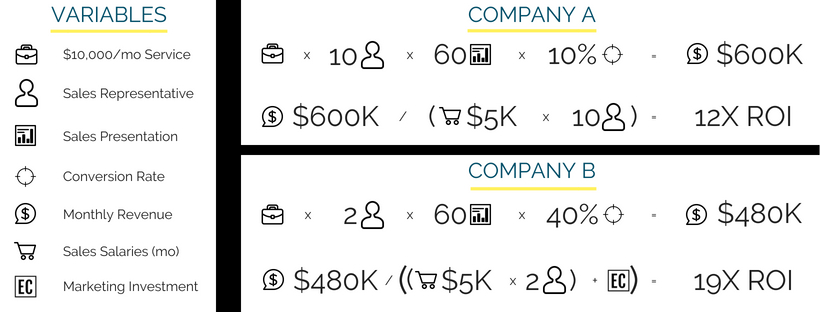How To Measure The ROI Of Your Marketing Strategies?
What will be the ROI of your investment in marketing? This is a question that every decision maker has to answer when an investment in marketing is being considered. Having a good marketing strategy and disciplined execution are not enough to generate sustainable growth.
Do you need to invest in marketing? NO! The truth is that you can make money with just a good product (or service) and a team of people selling it.
Is it efficient to run a business without investing in marketing? ABSOLUTELY NOT! Great marketing will make it easier for your salespeople to close deals and for your business to grow.
Think about a Football team without a quarterback. Will they be able to score? Of course they will, but it will take A LOT of work and heavy lifting. Each yard will present many obstacles as the team will have to go by almost every defensive member from the opposing team.
Now picture that same team with a quarterback that makes great plays. It will be A LOT easier for that same team to score.
Also, just having a quarterback doesn't mean that your team will score easier. You must have a good quarterback following a good strategy.
A salesperson presenting a product that has a memorable name & logo, using a typeface and colors that communicate the right message, and is in front of clients that have already engaged with your brand through other mediums, will have a higher chance of closing the deal.
Let’s do the math quickly to prove this. We’ll compare two companies, one that only invests in sales and another one that invests in sales and marketing. Company A is “All about sales” and company B “Balances their budget” between sales and marketing.
Company A
Has a $10,000/mo service, and 10 sales representatives that make 60 sales presentations a month (almost 3 per day) and close at a 10% rate. This means they have monthly sales of $600,000. For the purpose of this example let’s set a fixed annual salary of $60,000 for the sales representatives (which means $5,000/mo).
This means that the monthly investment of $50,000 in salaries is generating a $600,000 return which is a 12X ROI (there are always other costs but we’ll keep it simple for this example).
Company B
Has the same $10,000/mo service, but only 2 sales representatives that make 60 presentations a month but close at a 40% rate because they get higher quality leads thanks to the marketing efforts. This means they have monthly sales of $480,000. They pay the same salary to their sales representatives and spend $15,000/mo in marketing, including marketing consultants as well as a budget for advertisement.
My example is with marketing consultants and not employees because I’m biased ;)
This means that the monthly investment of $25,000 in sales and marketing is generating a $480,000 return which is a 19X ROI.
19X ROI > 12X ROI
Marketing + Sales > Just Sales
Back to our original question. How can you be sure that an investment in marketing will translate into sales growth?
In business, and also in life, uncertainty is the enemy. We all want concrete and accurate answers to our questions. We want to know what is going to happen, before it happens, so that we can be prepared.
Because as humans, we hate wasting our resources!
This goes in line with our survivor-bias because for many years our life could end quickly if we didn’t use our resources wisely.
Too much energy spent on a failed hunting trip could cost us our lives. An unexpected change in the weather could put our lives in danger by ruining the crops.
We often danced, made sacrifices, and conducted as many rituals as possible to get the gods to favor us so that we could have the results we desired.
Although our context has changed, and our survival is not so dependent on the outcome of a few critical events like hunting or farming, we still are heavily affected by uncertainty. Anxiety, depression, heart disease, cancer… all of these diseases can likely be associated with people not knowing how to deal with uncertainty.
I get it, you don’t want uncertainty when making decisions about how to invest your marketing budget. So, what is the ROI of the investment you will make with Elisha Consulting?
Calculating The ROI Of Your Marketing Investment
In any functional area of a business, decision makers strive to find ways to predict the outcomes of their decisions with as much accuracy as possible.
Statistics have, on the average, increased our capacity to “predict the future”. With tools such as regressions, we can understand how one variable (or a group of variables) affect another one. Theoretically, we could build a model with likes, comments, follows, blog views, and clicks as the “explanatory variables” and money spent by customers as the “response variable” to understand how our strategic digital marketing efforts drive revenue growth.
Notice the “on the average” in my previous statement.
It is important because that is the way in which the results of a regression MUST be stated. Let’s say we run the regression we were talking about, and find that there is a high correlation between comments and money spent in your e-commerce store. If that is the case, you CANNOT say “the more comments a follower makes, they more they will spend on your e-commerce store.”
You MUST say, “on the average, an increase in X amount of $ spent by a customer can be explained by the number of comments they make on your posts”. I don’t want to get too technical here, but the point is that the “on the average” lets the statistician off the hook, because:
Correlation doesn’t mean causality
This is data from the past and in the future things could change (i.e. Google makes more than 2 changes to its algorithm EVERY DAY)
But don’t despair!
There are many ways to measure your marketing efforts to have a better understanding of how to do more of what is working and less of what is not working.
But in order to transform numbers into knowledge that can be put into action, proper processes and tracking must be in place. This is what we call the professionalization of marketing.
Professionalizing Your Marketing To Use Data Efficiently
Let’s start with a simple formula (don’t worry, no more regressions… for now).
Number of Prospects x Conversion Rate x Profit per Transaction (Price - Cost) = Total Income
Easy right? Your income will depend on how many people are in your target market, how many of these you convert into clients, and how much money you make every time they buy.
Based on this simple formula, you could have a positive ROI in your marketing investments if:
A: You increase the numbers of prospects (i.e. an awareness campaign that increases your followers or email list)
B: You increase your conversion rate (i.e. improving the headline of your email campaigns to go from 10% open rate to 30% open rate)
C: Decrease the cost of your products or services (i.e. eliminating a recurring investment that you are making of Google or Facebook Ads that is not generating positive returns)
D: Increase your amount spent per transaction (i.e. identifying that you might have bundling opportunities)
It seems very simple, but it is not easy. One of the biggest barriers to better marketing is that most businesses don’t have proper processes and tracking. Nowadays, with the growth of digital marketing, it is easier to make calculations such as these.
Yet, many people don’t even have their websites connected to Google Analytics (which is FREE). Also, most people don’t have a clear map of their customer’s journey.
Once, we met with a prospect that was spending more than $1,000 a month on Google AdWords and didn’t have their website connected to Google Analytics. This means that THEY HAD NO IDEA if that investment of $12,000 per year was actually generating a positive ROI.
Marketing, in essence, is about understanding which specific activities are helping increase sales. But in order to IDENTIFY those specific activities, you MUST have clear processes and tracking systems because if you don’t it’s basically like making blind bets.
It is true, as we have stated before, that is hard to find certainty in most things. But that doesn’t mean we shouldn’t strive to get as much certainty as possible. Especially nowadays, that we have so many technology tools at our disposal.
Understanding Your Customer’s Journey
One of the biggest obstacles that we face, when doing marketing, is that we tend to forget what it is to be a BUYER when we become a SELLER.
Most businesses want a Facebook Ads or a Pay Per Click campaign that will generate instant sales and tend to forget about how they behave as a buyer. When was the last time you bought something directly because of a Facebook Ad?
As sellers, we tend to forget that there are several steps that need to happen before someone makes the decision to buy something. This is usually called the customer’s journey and explains how people go from having no idea about your brand and products, to becoming someone who buys EVERYTHING you sell and can’t stop talking about it.
Wouldn't we all want clients like the Apple fans that sacrifice sleep, stand in line for hours, and all to pay hundreds of dollars for a product that some might consider over-priced? Yet, for them, all that matters is being the first to experience it and they’ve gotten so much value from Apple that it’s worth it.
Do you want raving fans? Then, you have to take time to map and understand your customer’s journey before you are able to improve it. In fact, most people think that the journey ends when people buy but great marketers now that it is at that moment when things are actually getting started.
Each map should be different for every company, but in essence, there are 5 key steps in this journey:
Unknown
Awareness
Consideration
Decision
Fan
UNKNOWN: This is when people have no idea about your brand or your products. They might not even know that the product you are selling exists and that they have a problem that can be solved with what you sell (think about Airbnb or Uber when they were starting).
AWARENESS: This is when people know about you and your products but they don’t have the need yet.
CONSIDERATION: This is when people have identified they need a product and are evaluating their options.
DECISION: This is the moment people actually make a financial transaction and goods exchange hands. Money goes one way and a product goes the other way.
FAN: This is when people buy almost every product you sell, become advocates of your brand, and can even influence others to buy your product.
This is just the MOST SIMPLE customer journey map that you could make. In each of those different key locations, you could expand (and should) to understand each step with as much detail as possible (i.e. customers usually become advocates before they are fans).
Also, this is NOT a linear journey. For each brand, each of these steps (and timelines for each) could be completely different.
A restaurant might see that whole cycle happen in just a few months while a car company might have to wait years before that happens.
So, how can you begin to map your brand’s customer journey?
Mapping & Improving Your Customer’s Journey
This can be complicated when you are just starting. To get started, you might have to make educated guesses based on information available about your industry and competitors. But if your business has been operating for several years, there is NO EXCUSE for not having at least a high-level map of your customer’s journey.
One of the biggest obstacles, as we stated before, is that most businesses don’t have measuring mechanisms in place. And if they do, just having a lot of data doesn’t solve this problem by itself. There needs to be a strategic analysis of that data to understand what it means in relation to your customer’s journey. The data can be:
Number of orders
Size of orders
Time & date of orders
Geographical location of orders
Clicks
Subscriptions
Followers
Likes
Email openings
Add-ons to a shopping cart
Etc.
These all need to be grouped (in line with the different key moments we talked about) and also need to be tested for accuracy (i.e. sometimes bots may target your website and some of the visits or clicks you see in a certain day might have to be discounted).
Once you have your map, you have to assign a monetary value to each of those key moments. The main variables you want to have are:
Customer Lifetime Value (LTV): this means how much is a client worth for your business. In other words, over the course of their life how much is each client buying from you.
Customer Acquisition Cost (CAC): this means how much are you spending to get someone to get to the DECISION step and actually buy your product. Even if you don’t have marketing spending in place, there is always a cost of acquiring a client, because it can be the salary you are paying to your sales team or the rent you are paying at a particular location that allows you to get people to walk into your store.
Customer Retention Rate: this means how long are customers staying with you. After their first purchase, how many more times are clients buying from you? And how many of your clients stop buying from you?
Once you have a layout of your customer’s journey map and have a clear understanding of your LTV, CAC, and Retention Rate, you can begin to understand how to calculate the ROI of your marketing investments.
I say begin because there is still A LOT of work to do at this point.
Need help doing so? Send us a message so that we can jump on a call.



